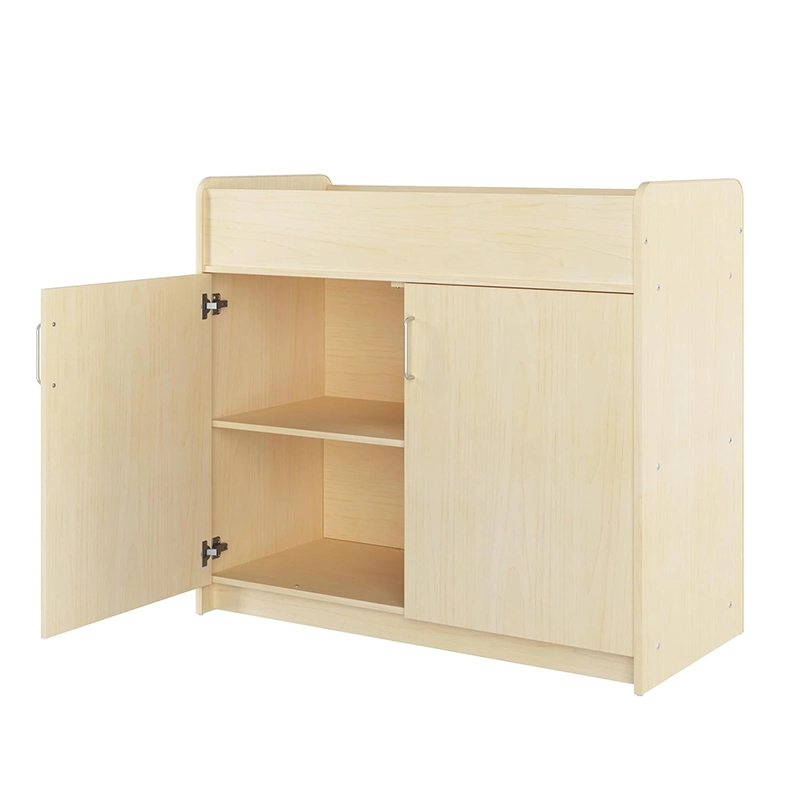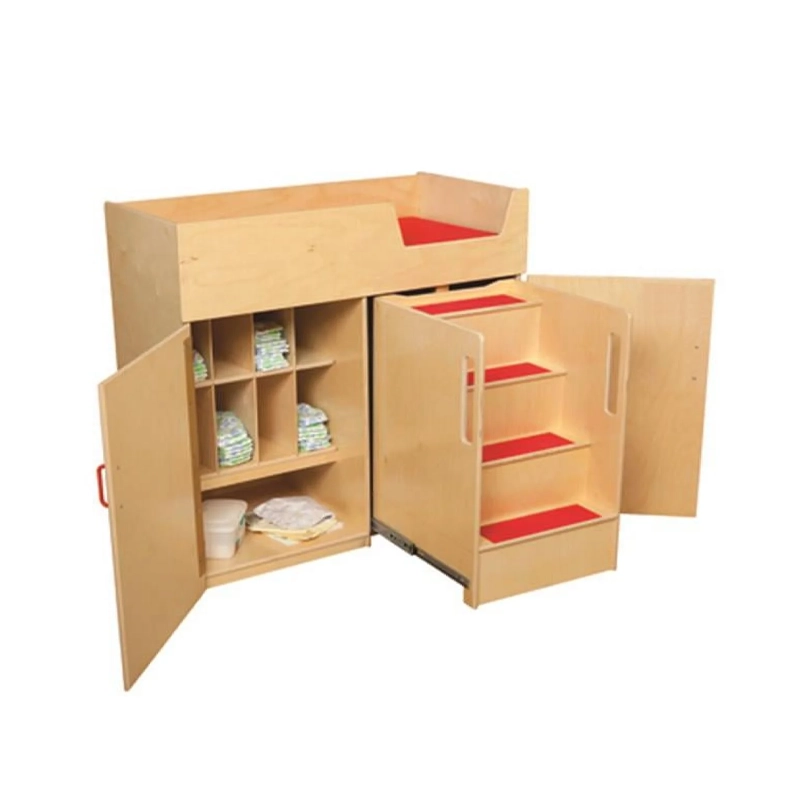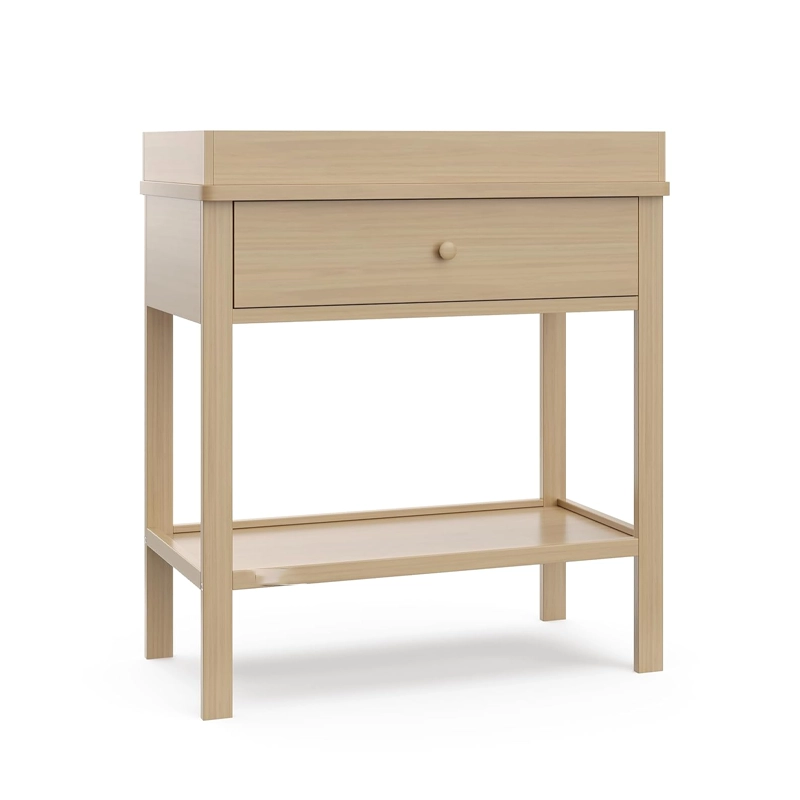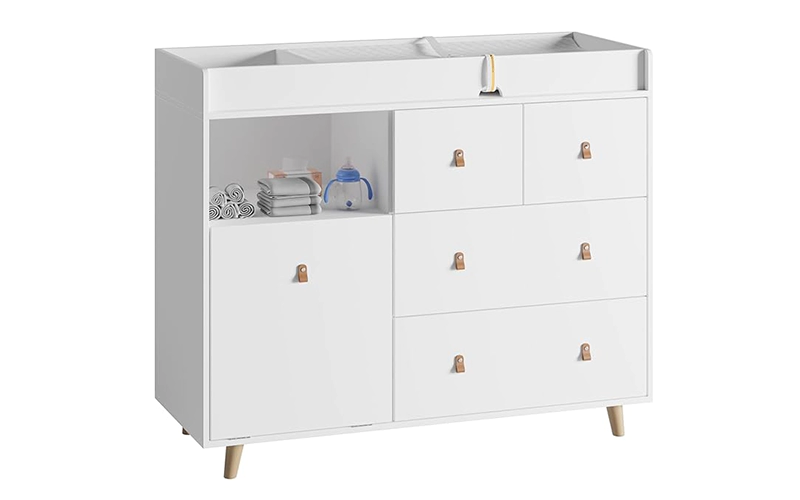
Wickeltisch für Kita und Vorschule: Sichere und praktische Lösungen
Unsere Wickeltische sind funktional und sicher zugleich und bieten eine praktische Lösung für Erzieher. Sie bestehen aus langlebigen Materialien und sind benutzerfreundlich, während sie Kindern und Mitarbeitern Sicherheit und Komfort bieten. Unsere Wickeltische sind in verschiedenen Ausführungen erhältlich und können individuell an Ihre Bedürfnisse angepasst werden. Sie sind die perfekte Ergänzung für jeden frühkindlichen Bildungsbereich. Ob platzsparende Designs oder umfangreichere Aufbewahrungsmöglichkeiten – wir haben die perfekte Lösung für Ihr Klassenzimmer.
Unser Sortiment an Wickeltischen
Bei Winningkidz bieten wir verschiedene Wickeltische für Vorschulkinder an, die den spezifischen Anforderungen von Kindertagesstätten, Vorschulen und frühkindlichen Bildungseinrichtungen gerecht werden. Von kompakten, platzsparenden Ausführungen bis hin zu größeren Einheiten mit viel Stauraum – jeder unserer Wickeltische ist auf Langlebigkeit und Sicherheit ausgelegt. Unsere Produkte sind individuell anpassbar und bieten so Funktionalität und Effizienz für unterschiedliche Klassenräume. Ob Sie einen einfachen Wickeltisch für kleinere Räume oder ein anspruchsvolleres Design für stark frequentierte Bereiche benötigen – wir haben die perfekte Lösung für Ihr Klassenzimmer.

Wickeltisch für die Kindertagesstätte mit Schrank

Pflegezentrum mit Treppenwickeltisch

Wickeltisch für Kleinkinder

Wickeltisch mit geformter Oberseite

Wickeltisch in Natur

Wickeltisch mit Auflage

Wickeltisch für Kleinkinder

Wickeltisch mit Schublade

Wickeltisch mit Schiebetüren

Eckwickeltisch

Klappbare Wickelstation mit Rädern

Wandmontierte Wickelstation
Führender Anbieter von Wickeltischen
Bei Winningkidz bieten wir mehr als nur hochwertige Möbel für die frühe Kindheit wie Wickeltische; wir bieten umfassende Lösungen, die die Funktionalität und Sicherheit Ihrer Lernumgebung verbessern. Mit über 20 Jahren Erfahrung kennen wir die besonderen Bedürfnisse von Kindertagesstätten, Kindergärten und frühpädagogischen Einrichtungen. Dank dieser Expertise können wir Produkte und Dienstleistungen anbieten, die den spezifischen Anforderungen moderner Bildungsräume gerecht werden.
Unsere Wickeltische zeichnen sich durch ihre robuste Konstruktion, kindersichere Materialien und durchdachtes Design aus. Ob kompakte Lösungen für wenig Platz oder größere Einheiten mit integriertem Stauraum – unsere Wickeltische sind vielseitig und praktisch. Jedes Produkt ist auf Sicherheit und Funktionalität ausgelegt, damit sich Betreuer einfach und sicher um die Bedürfnisse ihrer Kinder kümmern können. Darüber hinaus halten wir uns an internationale Sicherheitsstandards, sodass Sie sicher sein können, dass unsere Produkte die Branchenanforderungen erfüllen oder übertreffen.
Neben der Qualität unserer Produkte legen wir auch Wert auf erstklassigen Service in jeder Phase des Prozesses. Von der fachkundigen Beratung bei der Auswahl des passenden Designs für Ihre Räumlichkeiten bis hin zu schnellem Versand und reaktionsschnellem Kundenservice – wir sorgen für ein reibungsloses Erlebnis. Unser Team arbeitet eng mit Ihnen zusammen, um Ihre spezifischen Anforderungen zu verstehen und maßgeschneiderte Lösungen zu entwickeln, die Ihnen helfen, Ihre Räumlichkeiten optimal zu nutzen und gleichzeitig Ihr Budget einzuhalten.
Häufig verwendete Materialien für Wickeltische
Wickeltische sind ein unverzichtbares Möbelstück in Kinderzimmern und sorgen für Komfort und Sicherheit beim Windelwechseln. Hier sind einige gängige Materialien, die für ihre Herstellung verwendet werden:
-
Holz Holz wird oft wegen seiner Langlebigkeit und Ästhetik für Wickeltische verwendet. Harthölzer wie Eiche oder Ahorn sorgen für Stabilität, während weichere Hölzer wie Kiefer eine leichtere und günstigere Alternative darstellen. Viele Wickeltische aus Holz sind zudem mit einer Schutzbeschichtung versehen, die Feuchtigkeit und Abnutzung widersteht.
-
Metall Wickeltische aus Metall werden wegen ihrer Robustheit und einfachen Reinigung geschätzt. Typischerweise aus Stahl oder Aluminium gefertigt, bieten diese Tische ein moderneres Aussehen und werden aufgrund ihrer Langlebigkeit manchmal auch in gewerblichen Umgebungen eingesetzt.
-
Kunststoff Wickeltische aus Kunststoff sind leicht und oft günstiger. Sie lassen sich leicht reinigen und transportieren, was sie zu einer guten Wahl für temporäre Aufbauten oder den mobilen Einsatz macht. Hochwertige Kunststoffe bieten ausreichende Haltbarkeit ohne das Gewicht von Holz oder Metall.
-
Spanplatte oder MDF Diese Holzwerkstoffe sind bei preisgünstigen Wickeltischen weit verbreitet. Sie bestehen aus komprimierten Holzpartikeln oder -fasern, die anschließend mit Laminat oder Furnier überzogen werden. Sie sind zwar nicht so langlebig wie Massivholz, dafür aber oft leichter und in verschiedenen Ausführungen erhältlich.

Was ist ein Wickeltisch?
Ein Wickeltisch ist ein speziell entwickeltes Möbelstück zum Wickeln von Babys. Er bietet eine stabile, erhöhte Oberfläche, die das Wickeln für Eltern und Betreuer komfortabler macht. Die meisten Wickeltische verfügen über Sicherheitsfunktionen wie Schutzgitter, Sicherheitsgurte und Staufächer für Windeln, Feuchttücher und andere Babyutensilien.
Warum brauchen Sie einen Wickeltisch?
Ein Wickeltisch ist nicht nur praktisch, sondern trägt auch entscheidend zur Sicherheit, Ordnung und Hygiene bei. Hier sind die wichtigsten Vorteile:
Sicherheit
Wickeltische für Vorschulkinder sind mit erhöhten Kanten und Sicherheitsgurten ausgestattet, um ein Herunterrollen des Babys beim Wickeln zu verhindern. Dieses Designmerkmal bietet einen sicheren, separaten Platz zum Wickeln und verringert so das Sturzrisiko von höheren Oberflächen wie Betten oder Sofas.
Ergonomie
Wickeltische sind in der Regel so hoch, dass die Pflegekräfte die Windeln wechseln können, ohne sich übermäßig bücken zu müssen. Dies kann Rückenschmerzen und Beschwerden vorbeugen und den Wickelvorgang für Eltern und andere Pflegekräfte angenehmer gestalten.
Bequemlichkeit
Viele Wickeltische verfügen über integrierte Ablagemöglichkeiten für Windeln, Tücher, Cremes und andere wichtige Dinge. So ist alles in Reichweite und der Windelwechselvorgang geht schneller und effizienter.
Hygiene
Ein Wickeltisch bietet einen speziellen, reinigbaren Bereich zum Windelwechseln. Dies hilft, Unordnung zu vermeiden und erleichtert das Aufräumen nach dem Windelwechseln, was zu einer besseren Hygiene im Kinderzimmer beiträgt.
Platzoptimierung
In kleineren Kindergärten kann ein Wickeltisch für Vorschulkinder als multifunktionales Möbelstück dienen, das manchmal über Schubladen, Regale oder sogar ein umwandelbares Design verfügt, sodass er später als Kommode oder Aufbewahrungseinheit verwendet werden kann.
Routine
Ein eigener Wickelbereich kann dazu beitragen, einen festen Tagesablauf für Babys zu schaffen, der ihnen Trost spendet. Er trägt dazu bei, eine vorhersehbare Umgebung und Routine zu schaffen, die das Sicherheitsgefühl des Babys stärkt.
Arten von Wickeltischen
Wickeltische gibt es in verschiedenen Ausführungen, um unterschiedlichen Bedürfnissen, Vorlieben und Platzverhältnissen im Kinderzimmer gerecht zu werden. Hier finden Sie einige gängige Wickeltischtypen:

Standard-Wickeltisch

Tragbarer Wickeltisch

Eckwickeltisch

Wandmontierter Wickeltisch

Wickeltisch-Kommode-Kombination

Wickeltischauflage
So wählen Sie den besten Wickeltisch für Ihre Bedürfnisse
Um den perfekten Wickeltisch zu finden, fragen Sie sich:
- Wie viel Platz habe ich? (Für kleine Räume ist möglicherweise eine kompakte oder wandmontierte Option erforderlich.)
- Möchte ich eine langfristige Lösung? (Ein Tisch im Kommodenstil hält über die Windelphase hinaus.)
- Wie hoch ist mein Budget? (Hochwertige Holzmodelle sind haltbarer, aber teurer.)
- Benötige ich zusätzlichen Speicherplatz? (Denken Sie an Regale und Schubladen.)
Indem Sie Ihre Anforderungen bewerten, können Sie einen Wickeltisch auswählen, der Komfort und Sicherheit bietet.
Worauf Sie bei der Auswahl eines Wickeltisches achten sollten
Bei der Auswahl eines Wickeltisches für die Kindertagesstätte müssen verschiedene wichtige Faktoren berücksichtigt werden, um sicherzustellen, dass er praktisch, sicher und bequem für Sie und Ihr Baby ist. Hier ist eine Übersicht der wichtigsten Überlegungen:
-
1. Sicherheitsfunktionen Sicherheit sollte oberste Priorität haben. Achten Sie auf einen Wickeltisch mit stabiler Konstruktion und einem Schutzgitter an den Kanten, damit das Baby nicht herunterrollt. Das Schutzgitter sollte mindestens 5 cm hoch sein. Achten Sie außerdem auf eine Sicherheitszertifizierung oder die Einhaltung von Standards wie denen der Consumer Product Safety Commission (CPSC).
-
2. Lagerung Überlegen Sie, wie viel Stauraum Sie für Windeln, Tücher, Kleidung und andere Babyutensilien benötigen. Ein Wickeltisch mit Regalen, Schubladen oder Körben hilft Ihnen, alles griffbereit zu haben.
-
3. Größe und Höhe Wählen Sie einen Wickeltisch, der gut ins Kinderzimmer passt, ohne zu viel Platz einzunehmen. Die Höhe des Tisches sollte angenehm sein, um Rückenschmerzen beim Wickeln zu vermeiden.
-
4. Material und Verarbeitungsqualität Achten Sie auf langlebige Materialien, die leicht zu reinigen und zu pflegen sind. Holz ist eine beliebte Wahl, es gibt aber auch Optionen aus Metall und Kunststoff. Achten Sie darauf, dass der Tisch gut konstruiert ist und keine scharfen Kanten oder freiliegenden Befestigungselemente aufweist.
-
5.Vielseitigkeit Einige Wickeltische verfügen über Funktionen, die ihre Nutzbarkeit erweitern, z. B. umbaubare Designs, die später als Kommode oder Schreibtisch genutzt werden können. So können Sie den Wert Ihres Kaufs steigern.
-
6. Stil und Ästhetik Wählen Sie einen Wickeltisch, der zur Einrichtung Ihres Kinderzimmers passt. Es gibt viele Stile, von modern bis traditionell, sodass Sie einen finden sollten, der zu Ihren anderen Möbeln passt.
-
7. Preis Bestimmen Sie Ihr Budget im Voraus. Wickeltische variieren stark im Preis und werden von Faktoren wie Material, Marke und zusätzlichen Funktionen beeinflusst. Es ist wichtig, ein Gleichgewicht zwischen Kosten und den benötigten Funktionen zu finden.
Wickeltisch-Essentials
Ein gut ausgestatteter Wickeltisch macht das Windelwechseln einfacher, schneller und hygienischer. Wenn alle notwendigen Utensilien in Reichweite sind, ist sowohl für die Pflegekraft als auch für das Baby ein angenehmes Erlebnis gewährleistet.

Windeln
Windeln sind das Wichtigste auf Ihrem Wickeltisch. Halten Sie immer einen ausreichenden Vorrat bereit, um Last-Minute-Suchen zu vermeiden.

Babytücher
Sanfte, parfümfreie Babytücher helfen dabei, den Po Ihres Babys gründlich zu reinigen. Sie eignen sich auch zum Reinigen der kleinen Hände und des Gesichts.

Windeldermatitis-Creme
Eine gute Windelcreme beugt Windelausschlag vor und lindert ihn, sodass die Haut Ihres Babys weich und frei von Reizungen bleibt.

Wickelunterlage
Eine gepolsterte, wasserdichte Wickeltischauflage bietet Ihrem Baby eine bequeme Oberfläche und schützt den Wickeltisch gleichzeitig vor Verschmutzungen.

Windeleimer oder Mülleimer
Ein spezieller Windeleimer mit Geruchsverschluss hilft, unangenehme Gerüche zu vermeiden. Falls Sie keinen haben, funktioniert auch ein einfacher Mülleimer mit Deckel.

Spucktücher oder Waschlappen
Beim Windelwechseln kann es zu Unfällen kommen. Spucktücher oder kleine Waschlappen in der Nähe erleichtern das Saubermachen.

Handdesinfektionsmittel
Handdesinfektionsmittel sind für die Aufrechterhaltung der Hygiene unerlässlich, insbesondere wenn Seife und Wasser nicht sofort verfügbar sind.

Zusätzliche Babykleidung
Windeln laufen häufig aus. Wenn Sie zusätzliche Strampler, Bodys oder Schlafanzüge in der Nähe haben, können Sie Ihr Baby bei Bedarf leichter umziehen.

Schnuller oder kleines Spielzeug
Manche Babys werden beim Windelwechseln unruhig. Ein Schnuller oder ein kleines Spielzeug kann helfen, sie abzulenken und zu beruhigen, sodass der Vorgang reibungsloser verläuft.
Wie viele Wickeltische benötigen Sie in Ihrer Kindertagesstätte?
Die richtige Anzahl an Wickeltischen für Ihre Kindertagesstätte ist entscheidend für Effizienz, Hygiene und Komfort. Die folgende Tabelle bietet eine allgemeine Richtlinie basierend auf der Anzahl der Säuglinge und Kleinkinder in Ihrer Betreuung.
| Anzahl der Säuglinge/Kleinkinder | Empfohlene Anzahl Wickeltische | Argumentation |
|---|---|---|
| 1 - 5 | 1 | Für kleine Kitas mit geringer Wickelfrequenz reicht ein Tisch aus. |
| 6 - 10 | 2 | Reduziert Wartezeiten und ermöglicht einen reibungsloseren Windelwechselablauf. |
| 11 - 15 | 2 - 3 | Ermöglicht mehreren Pflegekräften die gleichzeitige Arbeit und sorgt für Hygiene. |
| 16 - 20 | 3 - 4 | Minimiert Staus, sorgt für Effizienz und verhindert lange Wartezeiten. |
| 21 - 30 | 4 - 5 | Unverzichtbar für Kindertagesstätten mit hoher Kapazität, um den Windelwechsel zu optimieren. |
| 30+ | 5+ | In großen Kindertagesstätten sind für eine bessere Erreichbarkeit möglicherweise mehrere Stationen in unterschiedlichen Räumen erforderlich. |
Wickeltisch-Abmessungen
Die Wahl der richtigen Wickeltischgröße ist entscheidend für einen komfortablen, sicheren und platzsparenden Wickelplatz. Die ideale Größe hängt von Faktoren wie dem verfügbaren Platz im Kinderzimmer, der Körpergröße der Pflegekraft und dem Stauraumbedarf ab.

Die meisten Wickeltische entsprechen den gängigen Größenrichtlinien, um Standard-Wickelauflagen aufzunehmen und eine angenehme Höhe für Pflegekräfte zu bieten. Hier sind die typischen Maße:
- Breite: 28 bis 36 Zoll (71 bis 91 cm)
- Tiefe: 17 bis 24 Zoll (43 bis 61 cm)
- Höhe: 34 bis 42 Zoll (86 bis 107 cm)
Diese Abmessungen bieten ausreichend Platz, damit ein Baby bequem liegen kann, und sorgen dafür, dass die Utensilien immer in Reichweite sind.
Benutzerdefinierte Abmessungen
Wir bei WinningKidz wissen, dass jede Kindertagesstätte, Kindertagesstätte und Einrichtung für die frühe Kindheit individuelle Platzanforderungen hat. Deshalb bieten wir Wickeltische in individuellen Größen an, die perfekt auf Ihre Bedürfnisse zugeschnitten sind. Ob Sie eine kompakte Lösung für einen kleinen Raum oder eine größere, multifunktionale Wickelstation benötigen – unser Team fertigt den perfekten Wickeltisch nach Maß für Sie.
Warum einen maßgefertigten Wickeltisch wählen?
-
1. Perfekte Passform für Ihren Raum Nicht alle Räume sind gleich gestaltet, und Standardwickeltische sind nicht immer die beste Wahl. Unsere individuellen Designs sorgen dafür, dass sich Ihr Wickeltisch nahtlos in Ihre Räumlichkeiten einfügt, egal ob es sich um eine kleine Kindertagesstätte oder eine große Kita handelt.
-
2. Einstellbare Höhe für Komfort Betreuer unterschiedlicher Körpergröße benötigen einen Wickeltisch für Vorschulkinder, der die Rückenbelastung minimiert. Wir können die Höhe individuell anpassen, um maximalen Komfort für häufige Nutzer zu gewährleisten.
-
3. Personalisierte Speicheroptionen Jede Kindertagesstätte oder jedes Kinderzimmer hat andere Aufbewahrungsbedürfnisse. Wählen Sie aus: ✔ Offenen Regalen für einfachen Zugriff auf Windeln und Tücher ✔ Schubladen, um Vorräte versteckt und organisiert aufzubewahren ✔ Schränken für zusätzlichen Stauraum und eine saubere Optik
-
4. Auswahl der Materialien und Oberflächen Wählen Sie aus hochwertigem Holz, MDF oder Metall in verschiedenen Ausführungen, passend zu Ihren vorhandenen Möbeln. Alle unsere Materialien sind ungiftig und kindersicher und sorgen so für eine sichere Umgebung für die Kleinen.
-
5. Besondere Merkmale Wir können zusätzliche Funktionen integrieren, wie zum Beispiel: - Integrierte Fächer für Windeleimer für mehr Komfort - Faltbare oder wandmontierte Ausführungen für kleine Räume - Feststellbare Räder für Mobilität und Stabilität
Wartungs- und Reinigungstipps
Wenn Sie diese Wartungs- und Reinigungstipps befolgen, können Sie sicherstellen, dass Ihr Wickeltisch während der gesamten Nutzung sicher, sauber und langlebig bleibt.
Regelmäßige Wartung
- Regelmäßig prüfen: Überprüfen Sie Ihren Wickeltisch mindestens einmal im Monat auf lose Schrauben, abgenutzte Teile oder scharfe Kanten, die das Baby verletzen könnten. Ziehen Sie lose Schrauben fest und glätten Sie raue Kanten nach Bedarf.
- Vermeiden Sie Übergewicht: Belasten Sie den Wickeltisch niemals mit mehr Gewicht als vom Hersteller empfohlen. Dies trägt dazu bei, die Struktur und Stabilität des Tisches zu erhalten.
- Oberflächen schützen: Verwenden Sie eine wasserdichte Wickelunterlage, um die Tischoberfläche vor verschütteten Flüssigkeiten und Unfällen zu schützen. Dies beugt Flecken und Wasserschäden am Holz oder Material des Tisches vor.
Tägliche Reinigung
- Nach Gebrauch abwischen: Wischen Sie die Oberfläche des Wickeltisches nach jedem Windelwechsel mit einem feuchten Tuch ab, um Rückstände oder verschüttete Flüssigkeiten zu entfernen. Verwenden Sie für hartnäckigere Flecken eine milde Seifenlösung mit Wasser.
- Regelmäßig desinfizieren: Es ist wichtig, den Wickelbereich keimfrei zu halten. Reinigen Sie den Tisch mindestens einmal täglich mit Desinfektionsspray oder -tüchern. Achten Sie darauf, dass die Reinigungsprodukte babysicher und frei von schädlichen Chemikalien sind.
- Lufttrocknen: Lassen Sie den Wickeltisch vollständig trocknen, bevor Sie ihn wieder mit Gegenständen bedecken. So vermeiden Sie Feuchtigkeitsansammlungen, die zu Schimmelbildung führen können.
Wöchentliche Grundreinigung
- Seife und Wasser: Reinigen Sie den Wickeltisch einmal wöchentlich mit einer milden Seifenlauge und warmem Wasser, um Schmutzablagerungen gründlich zu entfernen. Wischen Sie ihn mit einem weichen Tuch ab und achten Sie darauf, alle Ecken und Winkel zu erreichen.
- Wickelunterlage prüfen: Waschen Sie den Bezug der Wickelauflage in der Waschmaschine, wenn er aus Stoff ist, oder wischen Sie ihn mit einem Desinfektionsmittel ab, wenn er wasserdicht ist. Überprüfen Sie ihn auf Risse oder Beschädigungen.
- Gründlich trocknen: Stellen Sie sicher, dass Tisch und Unterlage vor der Wiederverwendung vollständig trocken sind, um feuchtigkeitsbedingte Probleme zu vermeiden.
Saisonale Pflege
- Zustand Holz: Wenn Ihr Wickeltisch für den Kindergarten aus Holz ist, behandeln Sie ihn alle paar Monate mit einem Holzpflegemittel oder einer Politur, damit das Holz nicht austrocknet oder reißt.
- Auf Schimmel prüfen: Überprüfen Sie in feuchtem Klima alle paar Monate auf Anzeichen von Schimmel, insbesondere in versteckten Bereichen unter der Wickelauflage. Reinigen Sie Schimmelflecken mit einer Lösung aus 1 Teil Bleichmittel und 10 Teilen Wasser.
- Setup neu bewerten: Überprüfen Sie regelmäßig die Einrichtung Ihres Wickelbereichs, um sicherzustellen, dass er weiterhin den Sicherheitsstandards entspricht und funktional ist, während Ihr Baby wächst.
FAQ
Für welches Alter ist der Wickeltisch geeignet?
Unsere Wickeltische sind für Neugeborene bis ca. 2 Jahre geeignet, abhängig von Größe, Gewicht und Aktivitätsniveau des Kindes. Wir empfehlen, den Tisch nicht mehr zu verwenden, sobald Ihr Baby sehr aktiv wird oder das vom Hersteller angegebene Gewichtslimit überschreitet.
Kann der Wickeltisch für andere Zwecke umgebaut werden?
Einige unserer multifunktionalen Wickeltische können in Aufbewahrungsschränke, Bücherregale oder Kinderschreibtische umgewandelt werden, wodurch ihre Nutzbarkeit und ihr Wert erweitert werden.
Wie kann ich die Sicherheit meines Babys auf dem Wickeltisch gewährleisten?
- Behalten Sie Ihr Baby immer mit einer Hand, um ein Wegrollen zu verhindern.
- Verwenden Sie den Sicherheitsgurt und stellen Sie sicher, dass er sicher befestigt ist.
- Stellen Sie den Wickeltisch auf eine ebene, stabile Oberfläche.
- Bewahren Sie schwere oder gefährliche Gegenstände außerhalb der Reichweite Ihres Babys auf.
Was kann ich anstelle eines Wickeltisches verwenden?
Wenn Sie keinen Wickeltisch haben, können Sie eine Wickelauflage auf einer stabilen Kommode oder einem Tisch, eine tragbare Wickelauflage auf dem Bett, Sofa oder Boden oder einfach ein weiches Handtuch oder eine Decke für einen schnellen Windelwechsel verwenden. Manche Eltern nutzen für zusätzlichen Komfort auch eine Waschmaschine, einen Trockner oder eine Badezimmerablage mit einer rutschfesten Matte. Egal welche Alternative Sie wählen, achten Sie immer auf eine stabile Oberfläche, halten Sie alles Wichtige griffbereit und lassen Sie Ihr Baby nie unbeaufsichtigt.
Wann sollten keine Wickeltische verwendet werden?
Sie sollten einen Wickeltisch nicht mehr verwenden, wenn Ihr Baby das empfohlene Gewicht oder die empfohlene Größe überschreitet. Dies ist je nach Modell in der Regel zwischen 10 und 11 kg oder zwei Jahren der Fall. Wird Ihr Baby außerdem sehr aktiv, rollt sich häufig um oder versucht abzuklettern, ist der Wickeltisch möglicherweise nicht mehr sicher.
Lohnt sich die Anschaffung eines Wickeltisches?
Der Kauf eines Wickeltisches kann sich lohnen, wenn Sie Wert auf Komfort, Ordnung und Ergonomie legen. Er bietet einen speziellen, hüfthohen Platz zum Windelwechseln und schont so Rücken und Knie. Viele Modelle verfügen über einen integrierten Stauraum, sodass Windeln, Feuchttücher und Babyutensilien immer griffbereit sind.
Wie hoch sollte ein Wickeltisch sein?
Ein Wickeltisch sollte in der Regel zwischen 86 und 107 cm hoch sein, abhängig von Ihrer Körpergröße und Ihrem Komfortniveau. Die ideale Höhe ermöglicht es Ihnen, Ihr Baby zu wickeln, ohne sich zu sehr bücken zu müssen, was Ihren Rücken schont. Wenn mehrere Betreuer den Tisch benutzen, kann die Wahl eines verstellbaren oder ergonomisch geformten Tisches von Vorteil sein.
Wie reinigt man einen Wickeltisch?
Um einen Wickeltisch zu reinigen, wischen Sie die Oberfläche täglich mit einer milden Seifenlauge oder einem babysicheren Desinfektionsmittel ab, um Schmutz und Bakterien zu entfernen. Für eine gründlichere Reinigung verwenden Sie ein ungiftiges Desinfektionsspray oder -tücher, insbesondere bei verschütteten Flüssigkeiten oder ausgelaufener Windel. Wenn Ihre Wickelauflage einen abnehmbaren Bezug hat, waschen Sie diesen regelmäßig gemäß den Pflegehinweisen in warmem Wasser. Räumen Sie außerdem die Aufbewahrungsbereiche auf, um die Wickelutensilien sauber und hygienisch zu halten. Trocknen Sie die Oberfläche nach der Reinigung immer gründlich ab, um Feuchtigkeitsansammlungen und Bakterienwachstum vorzubeugen.


